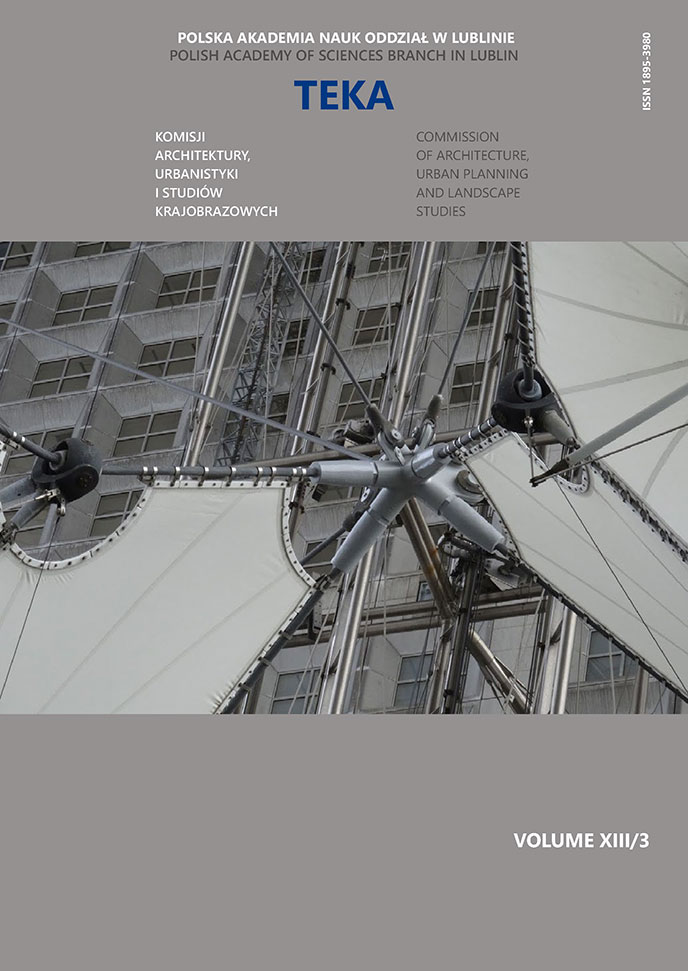About historic stonework in Kraków
Article Sidebar
Open full text
Issue Vol. 13 No. 3 (2017)
-
About historic stonework in Kraków
Anna Kulig7-13
-
Wstęp do metodologii oceny dotykowych modeli architektonicznych
Maciej Kłopotowski, Agnieszka Kłopotowska14-24
-
O mieszkalnictwie początku XXI wieku. Próba charakterystyki na podstawie europejskich realizacji
Maciej Kłopotowski25-42
-
Od rewaloryzacji idealnego miasta do ochrony historycznego krajobrazu Zamościa
Krzysztof Kazimierz Pawłowski43-52
-
Neolityczne megality Nałęczowa – debiut budownictwa na Lubelszczyźnie
Natalia Przesmycka, Lucjan Gazda53-59
-
Optimization of barrel vault surfaces using energetic potential method
Kajetan Sadowski60-66
-
“Straszny Dwór” (Haunted Manor) guesthouse in Tatarów in the Hutsul region and its designer Jerzy Romaszkan
Jacek Czubiński67-77
-
Participation of Stanisław Tomkowicz in the conservation of the Corpus Christi collegiate church in Biecz
Jacek Czubiński78-85
-
Shooting sport in the context of military objects in the middle war period of Poland
Wojciech Kocki, Elżbieta Przesmycka86-92
Archives
-
Vol. 15 No. 4
2019-12-30 6
-
Vol. 15 No. 3
2019-10-31 9
-
Vol. 15 No. 2
2019-06-28 12
-
Vol. 15 No. 1
2019-03-29 13
-
Vol. 14 No. 3
2018-10-28 14
-
Vol. 14 No. 2
2018-06-29 14
-
Vol. 14 No. 1
2018-03-30 13
-
Vol. 13 No. 4
2017-12-29 8
-
Vol. 13 No. 3
2017-09-29 9
-
Vol. 13 No. 2
2017-06-30 10
-
Vol. 13 No. 1
2017-03-31 10
-
Vol. 12 No. 4
2016-12-30 12
-
Vol. 12 No. 3
2016-09-30 10
-
Vol. 12 No. 2
2016-06-30 9
-
Vol. 12 No. 1
2016-03-31 8
-
Vol. 11 No. 4
2015-12-30 14
-
Vol. 11 No. 3
2015-09-30 7
-
Vol. 11 No. 2
2015-06-30 8
-
Vol. 11 No. 1
2015-03-31 11
Main Article Content
DOI
Authors
Abstract
Massive fragments of portals, mouldings, and columns which are stored in stone collections and museum storage rooms are today of no particular interest. They spur the visitors’ imagination only slightly; there, just a piece of stone, carved, yet incomplete, broken. Can this legacy, difficult in perception, be shown in a different way and made memorable? Can it be made close to the audience? The concepts of the pioneers of conservation of historical objects are worth referencing. Realized concepts testify for an attitude of respect towards the legacy and traditions. Gothic architectural details that were abandoned during demolitions of historical structures in the 19th century, have survived elsewhere, “incrusted” in other structures. It happened in the walls of Collegium Maius, The Bishop Erazm Ciołek Palace, Pusłowscy Palace, Lubomirscy Palace, Tadeusz Stryjeński Palace. They were often treated as native relics. Saved from destruction and from being forgotten they adorn facades, interiors and gardens. Perhaps the idea and the examples of stone collections will spur a reflection and inspiration in designers today.


